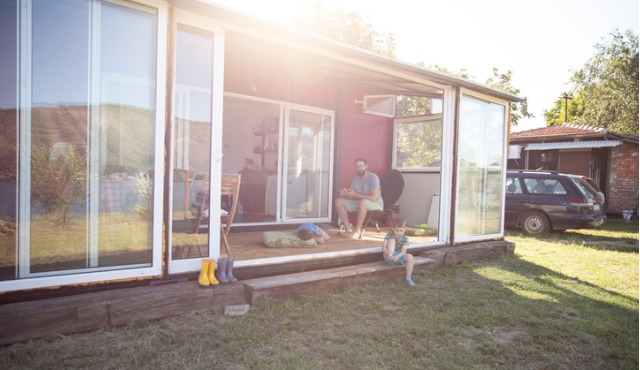Are you considering buying or building a shipping container home? The idea of having a shipping container home intrigues many people. Using an affordable container that has been used to ship products around the world has its advantages. Multiple containers can be fashioned together to make a home to suit your needs. Even a home with living space over a few different floors can be made using shipping containers.
While shipping container homes are relatively rare, it's a market that is continuing to grow thanks to the affordability it offers to homeowners. Shipping container houses are also eco-friendly, which is another excellent benefit. Here are some things you need to know before considering this type of housing:
How Do You Buy Shipping Containers?
The majority of shipping containers are constructed in China, which makes sense because they're used to ship manufactured goods around the world. Often these containers are only used once since it isn't cost-effective to return empty containers. Containers that have been used for multiple trips are less useful when building shipping container houses anyway, because of damage.
You can buy containers easily online and have them transported to your construction site. There are two main sizes available—20 or 40 feet—but you can sometimes find 45-foot containers too.
They have internal dimensions of 7’ 10” both in height and width. When you're building shipping container homes, the high-cube 40 foot contain might be better. The high-cube containers have an extra foot of height internally and because of that are a better choice when building a home.
Since you need to fit a floor and ceiling with insulation, the extra height is really valuable. The high-cube containers are more expensive, however, with costs between $4,000-5,000 typically.
How Much Do They Cost?
The cost of your shipping container home will depend very much on how large the home will be. Another factor is the quality of finish you choose and the design. Using more containers will increase your costs.
You can expect shipping container houses to range in price from about $50,000 for a small 20 foot home to more than $200,000 for a two-story home constructed from multiple containers. If you have the skills and experience, or are willing to learn, you can build this type of home for as little as $15,000 per container you use. Like modular homes, a shipping container home is going to be less costly than traditional housing.
Though if you plan to build your home yourself, you can underestimate the amount of work you’ll need to put in. Even though the home's basic structure is already done, there’s still going to be a lot of labor left to do. You'll need to pour the foundations, install a septic system, cut the container and weld, add insulation, fit pipes and electrical cords, just to name a few tasks.
The Pros of Shipping Container Housing
Lower Costs. If you can do all or most of the work yourself, you will save a lot on your home's construction. However, you do need to budget carefully to make sure your costs don’t get out of hand.
You can actually buy ready-made shipping container homes. These tend to be cheaper than the more traditional prefab buildings and are worth considering if you are looking at shipping container houses.
More Design Options. Thanks to the strength of the containers, they can be stacked eight high. This gives you a lot of options when it comes to the design of your home. Sections can be cut out of containers to join them together, though structural reinforcement may be required.
Speed of Construction. Since the building's main structure is already complete, a shipping container home can be fast to construct. There is preparation work needed, including foundations, but once that is done, pre-fabricated container homes can be finished in as little as 10 weeks.
Though if you are building it yourself, construction time is likely to be longer than you expect. Whether you do all the work yourself, bring in contractors or buy pre-fab containers, using shipping containers will save you a lot of time.
Strength. Containers are constructed to withstand high winds when onboard ships. So if they're built to stand up to rough seas, they should be strong enough for your lot's weather conditions.
The Cons of Shipping Container Homes
Structural Concerns. The strength of shipping containers has already been mentioned, but this is before you cut holes in them for doors and windows. This will naturally reduce the strength of the structure the more cuts that are made in the steel. These alterations could mean you need extra work completed to reinforce and seal the home.
Lack of Space. Basic shipping containers require a lot of things to make them livable. While you will have the basic structure, wiring, plumbing, walls, floors and ceilings still have to be fitted. This reduces the space in the structure, making it even more restricted.
Zoning Restrictions. If you're planning to build in a particular area, you need to be sure it will be allowed. Many places will have restrictions that prevent this type of home from being constructed, and you need to be sure the zoning laws allow it before you purchase land.
One of the most vital things to check when building container homes is whether you'll be able to get a building permit for what you would like to do.
Environmental Concerns. While using a used shipping container to construct your home might appear to be eco-friendly, it might not really be the case. Building this type of home means more steel being used than more traditional constructions. It also means containers are taken out of service, with more needing to be constructed to replace them.
Might be Harder to Finance. Given that shipping container housing is sort of a newer fad, it may be harder to find a bank willing to grant a construction loan. There are more issues for lenders to consider, including a lack of comparable sales to establish appraisal values. If you find a lender willing to finance a container home, it will probably require a more significant down payment.
If you like the style of shipping container properties, the reduced costs and ease of construction, this type of property could be a good choice for you. You can have a custom-designed home constructed for less and faster than traditional building methods, but just make sure the zoning rules allow it!
 Bill Gassett is a nationally recognized real estate leader who has been helping people buy and sell MetroWest Massachusetts real estate for the past 33 years. He has been one of the top RE/MAX REALTORS® in New England for the past decade. Gassett works for RE/MAX Executive Realty in Hopkinton, Massachusetts. In 2018, he was the No. 1 RE/MAX real estate agent in Massachusetts.
Bill Gassett is a nationally recognized real estate leader who has been helping people buy and sell MetroWest Massachusetts real estate for the past 33 years. He has been one of the top RE/MAX REALTORS® in New England for the past decade. Gassett works for RE/MAX Executive Realty in Hopkinton, Massachusetts. In 2018, he was the No. 1 RE/MAX real estate agent in Massachusetts.








